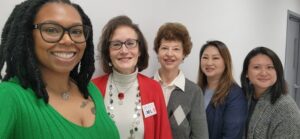Volume 38 Number 1 | February 2024
Yon Choi-Gomes, MAEd, MLS(ASCP); Robina Colclough-Davy, MS, MLS(ASCP); Lisa Hochstein, MS, MLS(ASCP); Melinda Liu, MLS(ASCP); and Angela Robinson, MS, MLS(ASCP)

After graduating and passing their certification exam, many of our students go on to accept positions at our affiliate hospital sites within the New York metropolitan area. As a result, our ethos, which cultivates equity and inclusion, is carried on into the clinical laboratories in which they work. This enables our students to build a strong community of healthcare professionals, with diverse backgrounds and experiences, who share a mission to transform and advance laboratory medicine.
Social Preparedness
One of our faculty member’s favorite memories is when she promoted Medical Laboratory Professionals Week at her job. The theme was “FACES of the LABORATORY.” Human Resources and the lab administration inquired to ensure the staff was well represented before being on display in the main lobby of the hospital. Her response was promptly and proudly, “I made certain I covered days/evenings/nights/weekends/anatomic and clinical divisions and all laboratory areas!” They were surprisingly not impressed, that is until they came down to see the display bulletin and noted the assortment of beautiful faces, because that is who we are as laboratory professionals. Due to our demographics in New York City, it is easy to find varied backgrounds, like Indian, Pakistani, Chinese, Vietnamese, Korean, Filipino, Jewish, African, Latin, Caribbean, European, to name just a few.
There is so much truth to the old phrase, “Variety is the very spice of life, that gives it all its flavor.” One of the greatest advantages of hailing from New York is the ability to form relationships with people from the farthest reaches of the globe. Our faculty has not only been fortunate enough to earn our degrees here, but we also have the privilege to educate as well. Our exposure to diversity as students now provides us with a suitable pedagogical approach in our classrooms. We can accommodate diverse learning strategies, incorporate engaging stories from our own experiences, and help cultivate empathy and respect. These two attributes are crucial when interacting with peers as well as future colleagues in the multifaceted workforce. Another benefit for embracing diversity is the preparedness of working in an interconnected world. Experiencing diversity enables our students to become skilled and competent to thrive wherever in the world they want to put down roots.
Opportunities to Increase Diversity and Inclusion in the Field
Although a fusion of backgrounds is well represented, it continues to be a work in progress. It is important to remember inclusivity goes beyond ethnicities and religions but also includes age, gender, academic, and socioeconomic factors. Taking advantage of opportunities to expose ourselves to a myriad of backgrounds makes it conducive to broadening our horizons and achieving open mindedness.
Here are some examples of opportunities to attract underrepresented students and future professionals:
- Attend health fairs at hospitals, community events, and colleges to attract non-MLS college students
- Attend career days at middle and high schools in various neighborhoods of social economic standing
- Post and engage on social media pages to promote scholarships, professional development activities, student and faculty achievements, program ASCP Board of Certification pass rates, and employment opportunities
- Become more active on LinkedIn
- Distribute fliers and circulate them to high school teachers and advisors, not just the students
- Guest speak at student organizations and Parent Teacher Association meetings
- Participate in charity events in the name of medical laboratory science
- Celebrate Medical Laboratory Professionals Week with events on hospital and college campuses, receive a proclamation from your local government official, and invite the local elected officials
- Establish professional clubs for students to engage in activities around the profession, increase camaraderie, and
potentially recruit students from non-CLS majors - Collaborate interprofessionally within healthcare and basic science arenas
The beauty of collaboration and networking with diversified backgrounds strengthens our commitment to unity. As medical laboratory scientists and technicians, we are focused together with one voice and one language. We actively serve our local community, while preparing to serve globally. With tolerance and understanding, we can create a mosaic of communal and professional coexistence.
Our authors work for the Clinical Laboratory Sciences Program at St. John’s University in Queens in New York, New York. Yon Choi-Gomes is Assistant Professor. Robina Colclough-Davy is Assistant Professor. Lisa Hochstein is Adjunct Associate Professor. Melinda Liu is Adjunct Assistant Professor. Angela Robinson is Adjunct Assistant Professor.